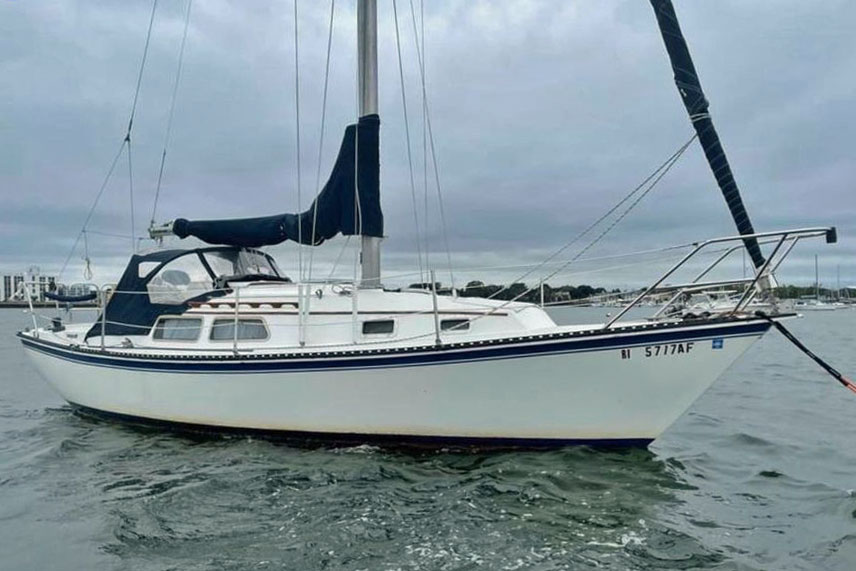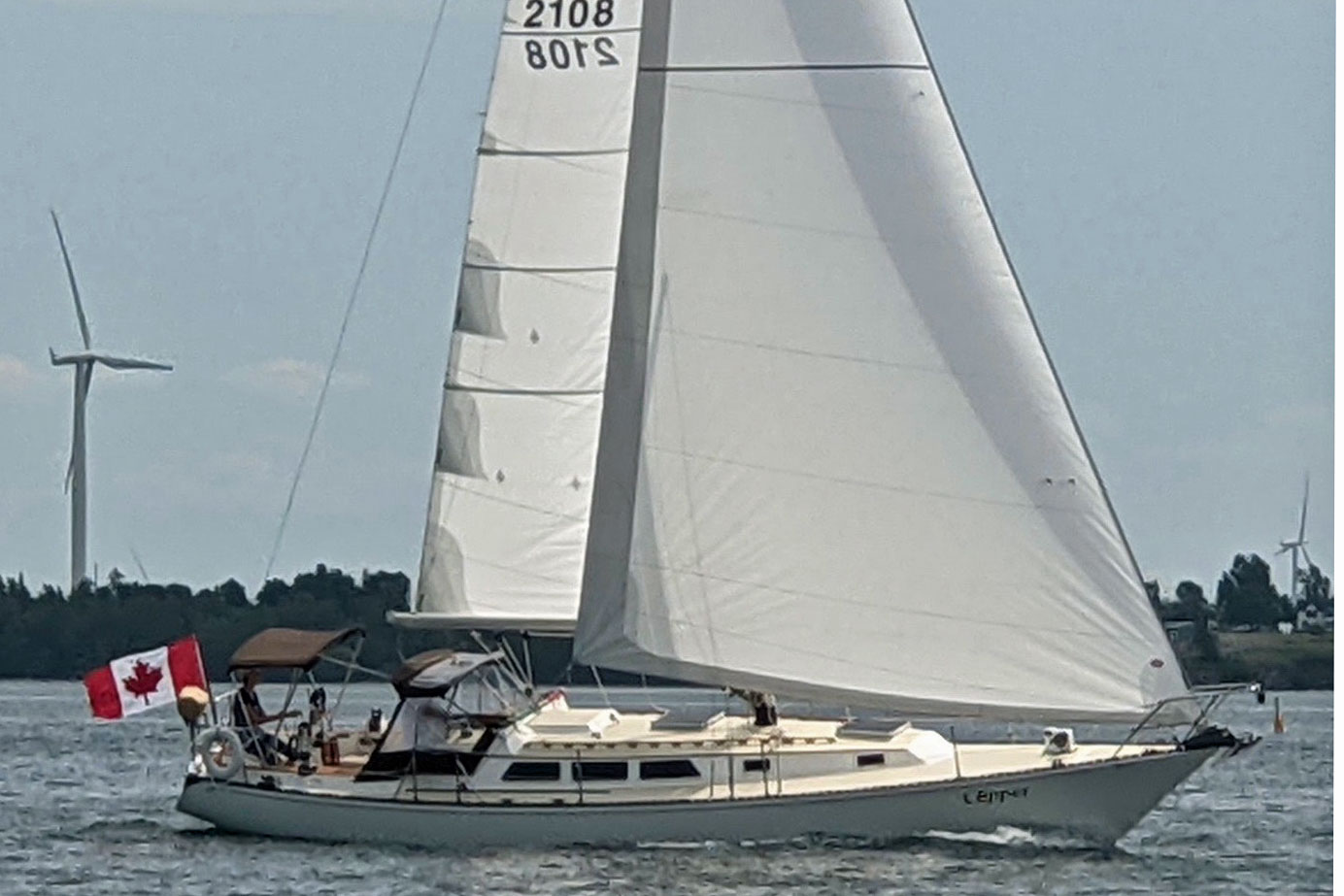- Home
- Newport Sailboats
Finding Your Perfect Sailboat: A Look at Newport Boats
Dreaming of days spent on the water, sails drawing full, the coastline blurring past? For countless recreational sailors, a Newport sailboat has been that perfect ticket to accessible cruising and spirited day sails.
 Newport 28
Newport 28Table of Contents
- Newport Boats: Where They Started
- What Makes a Newport Sailboat Unique?
- How Newport Sailboats Were Built
- Popular Newport Models & Their Performance
- Inside a Newport Sailboat: Comfort & Space
- Why Sailors Still Love Newport Boats
- Buying a Used Newport Sailboat: What to Check
- Final Thoughts on Newport Sailboats
Forget the cutting-edge designs or ultra-luxurious interiors; these boats carved out their own significant niche by simply delivering a practical, genuinely enjoyable experience. So, if you're eyeing a Newport sailboat for your next adventure, let's pull back the curtain on their story, design, and what they're really like.
Newport Boats: Where They Started
Our journey with Newport sailboats begins in 1964. That's when Newport Boats first set up shop in sunny Newport Beach, California. Their initial focus? Smaller sailing dinghies and daysailers, perfect for a recreational boating scene that was really starting to boom. To tackle the East Coast market, they soon launched a second factory in Gloucester, Virginia.
The company's history, while relatively brief, saw its fair share of changes. It moved through different owners—Browning Arms Company, then Elgin International—before Lockley Manufacturing acquired it in 1976, ushering in the Lockley Newport Boats era. By 1981, they were known as Gloucester Yachts. Production ultimately wrapped up in 1988. But even then, the story lingered: Classic Yachts of Chanute, Kansas, later acquired many of the molds, keeping a few popular models like the Gloucester 22 and the Lockley-Newport LN-23 in production until 2000.
What truly drove Newport, especially in its later years, seemed to be a clear mission: get affordable Newport sailboats into as many hands as possible. Often, this meant keeping the base price competitive by offering many standard items as optional extras. A shrewd move for the market they served.
What Makes a Newport Sailboat Unique?
Walk the docks, and you can often pick out a Newport sailboat even from a distance. They have a few distinct design calling cards. Notice their stern decks, for instance, forming the top of a substantial stern buoyancy tank. And unlike some boats of that period, their thwart and centerboard cases were typically all fiberglass—a nice touch. You’ll also frequently spot a fairly large bow tank and that unmistakable black vinyl rubbing trim along the gunwale.
While the naval architects behind every Newport sailboat model aren't always widely publicized, their designs certainly evolved. Early on, you'd find smaller craft like the Albacore (1964) or the incredibly popular Newport 16 (1965). As the company grew, they bravely stepped into larger cruising designs.
A significant leap, for example, came with the Newport 41S, penned by C&C Design in 1974. This wasn't just another cruiser; she was conceived as an International Offshore Rule racer-cruiser. That signals a clear move towards performance, though still thoughtfully balanced with cruising comforts. The 41S, for instance, sported a masthead sloop rig, a raked stem, and a fixed, swept fin keel with an internally mounted spade-type rudder.
Generally speaking, however, Newport sailboats—especially the smaller and mid-sized cruisers—were clearly designed for easy coastal jaunts and pleasant day sailing. They prioritized simple handling and a respectable turn of speed for their intended audience, rather than chasing racing glory or tackling extreme offshore voyages.
How Newport Sailboats Were Built
Most Newport sailboat hulls and decks were built with fiberglass. Back then, hand lay-up was the industry standard, and Newport certainly adhered to that. While some models, like the Newport 27, featured a hand-laid hull with a proper lead keel and bronze through-hulls, you might also find PVC gate valves elsewhere on board. This really highlights their practical approach to materials—a careful balance between cost and solid functionality.
Now, let's be honest: the build quality on some Newport sailboat models has, occasionally, been described as "so-so" by reviewers, particularly those aimed squarely at the budget end of the market. This isn't to suggest they were poorly built in a dangerous sense, but rather that certain compromises were made to hit that attractive price point. For instance, some earlier models from the 1970s and early 1980s have been known for issues with plywood-based keel stubs. If not maintained properly, these could certainly lead to leaks or separation over time. Leaky portlights and challenges with the hull-to-deck joint were also common refrains, often tied to the inherent difficulty of sealing flat windows onto curved fiberglass surfaces in that era. Yet, it's worth noting that many Newport sailboats have proven remarkably durable and long-lasting when given the proper care and attention.
Popular Newport Models & Their Performance
When we talk about the most successful and well-known Newport sailboat models, the Newport 27 immediately springs to mind. Dive into a Newport 27 review, and you'll consistently hear about it being a remarkably spacious coastal cruiser. It strikes a clever balance between accommodation and sailing manners for its size, frequently praised for its generous interior volume.
The Newport 28, designed by C&C and built by Capital Yachts, also stands out as a very popular cruiser-racer. With over a thousand built, it offers a good blend of performance and comfortable accommodations for its size. Owners often appreciate its responsive handling and ability to perform well in light to moderate air, making it suitable for both cruising and club racing. The later 28-2 version even featured a deeper keel for improved upwind performance.
The Newport 30, while considered a moderate-weight sailboat, generally puts in a pretty good performance for her class. Owners often note its stability and stiffness, though some report a bit of a challenge with weather helm, especially in heavier winds, and a tendency to round up in gusts. Good news, though: this can often be tamed with careful sail trim, and sometimes, a simple modification like a larger headsail or mid-boom sheeting can make all the difference. The Newport 30 was fundamentally designed as a day-boat or coastal cruiser, which is reflected in her relatively small fuel and water tankage.
If you're after a bit more zip, the Newport 41S marked a significant step up. As a true racer-cruiser, she boasted a higher degree of stability and righting capability, making her much more suited for offshore passages. Even so, like her smaller siblings, her original tankage for fuel and water could feel limited for extended bluewater cruising.
Generally speaking, Newport sailboats aren't going to be gracing the podiums of major regattas. But that's not their purpose. They offer a genuinely pleasant sailing experience for what they are. They're typically easy to handle and provide a stable platform for cruising, making them perennial favorites for families and those just getting started in sailing.
 Newport 41
Newport 41Inside a Newport Sailboat: Comfort & Space
Step below deck on a Newport sailboat, and you'll typically find a traditional aesthetic. Oiled teak joinery is a common sight, though you might occasionally spot wood-patterned Formica on horizontal surfaces. The overarching philosophy for interior layout was always about clever space utilization, aiming to maximize berths and amenities within the given hull size.
Take the Newport 27's cabin, for instance: you'd often find a small counter with a sink and icebox access to port, with an alcohol stove neatly opposite. Variations sometimes included a quarter berth or a fixed dinette. While dry storage was usually plentiful, water and holding tankage tended to be modest. Again, this reinforces their design as Newport cruising sailboats built for weekend trips, not necessarily long-term liveaboards. Headroom could be a consideration on some models, though the Newport 41S, in particular, boasts a generous 75 inches.
Ultimately, Newport sailboat interiors were crafted for function and comfort on those shorter trips and coastal adventures, providing just what you needed for a thoroughly enjoyable time afloat.
Why Sailors Still Love Newport Boats
Who typically gravitated towards Newport sailboats? Mostly, recreational sailors seeking an affordable way into boat ownership, or a straightforward, practical vessel for coastal cruising and day sailing. Their reputation in the sailing community is generally solid: reliable, no-frills boats that simply offer excellent value.
On the used boat market, Newport boats tend to hold their value quite well, especially those that have been diligently maintained. Given their robust fiberglass construction, they're often seen as ideal candidates for repowering projects. So, for those searching for used Newport sailboats, the market frequently presents some genuinely appealing opportunities.
While you won't find a single, grand owner's association specifically for "Newport" branded sailboats, owners certainly connect! They often find community within broader classic fiberglass yacht associations or lively online forums dedicated to older boats.
The enduring appeal of Newport sailboats truly lies in their role in making sailing accessible to a wider audience. They weren't built as luxury yachts or for breaking speed records. Instead, they consistently delivered a solid, dependable platform, allowing countless individuals to discover the pure joy of being on the water.
Buying a Used Newport Sailboat: What to Check
Just like any older fiberglass boat, if you're considering a Newport sailboat, it pays to be aware of a few common issues. As we touched on earlier, some models from the early 1970s and '80s might have plywood-cored keel stubs that, without proper attention, could lead to leaks. Leaky portlights are another frequent complaint—often due to the inherent challenge of sealing flat windows onto curved hulls. (Many recommend butyl rubber for resealing them properly). Similarly, the hull-to-deck joint can sometimes be a source of drips. These are all fairly common Newport sailboat problems that any savvy buyer will investigate.
When you're inspecting a Newport, pay particularly close attention to the condition of the chainplates. These were a known weakness in some earlier models, and their integrity is absolutely crucial to the rig. Finding upgraded chainplates is a definite bonus. For larger models like the Newport 30, modifications such as mid-boom sheeting can really improve sail handling and balance. And while the companionway hatch on the Newport 30 can be a bit cumbersome, it's generally a minor quirk in the grand scheme of things.
Ultimately, the maintenance history of any used Newport sailboat is paramount. Find a well-cared-for example, even with its inherent design quirks, and you could be looking at a fantastic and truly rewarding boat to own.

Download my eBook 'How to Avoid Buying the Wrong Sailboat!
It's not free sadly, but its $9.99 price tag could save you $$$$$$s.
Low Cost, but High Value!
Final Thoughts on Newport Sailboats
The Newport series of sailboats, though from a company no longer in production, leaves behind a proud tradition of approachable and practical boating. From nimble dinghies to capable coastal cruisers, and even that more performance-oriented racer-cruiser, Newport boats consistently offered a practical entry into the sailing world.
Sure, they had their common criticisms—a few construction compromises made for affordability, some design quirks—but these vessels, particularly the Newport 27, 30, and 41S, have more than proven their durability and seaworthiness over decades. For recreational sailors seeking a dependable, no-frills boat that offers genuine value and a straightforward sailing experience, a well-maintained Newport sailboat remains a compelling choice. They truly embody the spirit of practical cruising for the everyday enthusiast.
Resources & References
- https://en.wikipedia.org/wiki/Lockley_Newport_Boats
- https://registry.albacore.org/identify/Newport%20Boats
- https://www.cruisingworld.com/sailboats/newport-27-spacious-little-coastal-cruiser/
- https://en.wikipedia.org/wiki/Newport_41S
- https://sailboatlab.com/data_sheet/5114/0/https://sailboatlab.com/data_sheet/5123/0/
Recent Articles
-
Hans Christian 43: Classic Bluewater Cruiser & Liveaboard Sailboat
Dec 10, 25 04:37 AM
Explore the Hans Christian 43: a legendary heavy-displacement, long-keel sailboat. Read our in-depth review of its specs, design ratios, and suitability for offshore cruising and living aboard. -
Planning Your Sailboat Liveaboard Lifestyle: An Ocean Sailor's Guide
Dec 06, 25 05:18 AM
Seasoned sailors share their methodical risk analysis for planning a secure Sailboat Liveaboard Lifestyle, covering financial, property, and relationship risks. -
Marine Cabin Heaters: The Expert’s Guide to Comfort & Safety at Sea
Dec 05, 25 06:52 AM
Choose the best Marine Cabin Heaters for your vessel. Expert advice on diesel, paraffin, and hot water systems for year-round cruising comfort.












